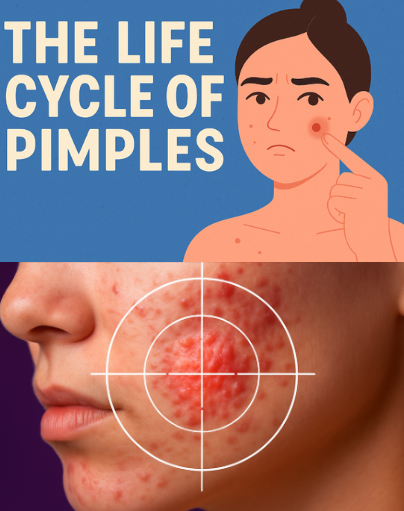
Acne doesn’t just appear overnight. By the time you notice a pimple, it has often been forming beneath the surface for days or even weeks. Understanding the life cycle of acne can help you treat breakouts more effectively, prevent future blemishes, and protect your skin from long-term damage like scarring or dark spots. Let’s explore the three stages of a pimple, what triggers them, and how to prevent and treat acne safely.
What is the Life Cycle of a Pimple?
Every pimple has a life cycle, and not all acne develops at the same speed. Some breakouts heal in a few weeks, while severe types can persist for months. The life span of acne varies based on the type and severity:
- Mild to moderate acne: Typically heals in 6–8 weeks.
- Nodular or cystic acne: Can last for weeks to months and often requires professional treatment.
By understanding how pimples develop, you can intervene early and minimize their impact.
Early Stage: When Acne Begins Beneath the Skin
At first, acne is almost invisible. Tiny pores in the skin, which release sweat and oil to keep your skin healthy, can become clogged by excess sebum and dead skin cells. These blockages form the foundation of whiteheads and blackheads:
- Whiteheads (closed comedones): Small, round, white bumps that form under the skin surface.
- Blackheads (open comedones): Appear black due to oxidation when exposed to air.
Even though these blemishes are not yet inflamed, they mark the start of the acne cycle. Early intervention at this stage can prevent progression to more severe acne.
Middle Stage: Growth and Inflammation
Once the pores are clogged, acne begins to expand beneath the surface. This is when you may notice:
- Papules: Small, red, raised bumps without pus. They indicate irritation as debris penetrates deeper skin layers.
- Pustules: As bacteria multiply in clogged pores, pus forms, causing swelling and inflammation. These bumps are tender and visibly filled with white or yellow pus.
At this stage, acne can become more noticeable and painful. Proper skincare and targeted treatments can stop these pimples from worsening.
Final Stage: Severe Acne Development
In the most severe cases, bacterial infections continue multiplying, causing inflammation in deeper layers of the skin. This leads to:
- Nodular acne: Hard, painful bumps beneath the skin, without pus.
- Cystic acne: Large, pus-filled lumps that rise to the surface, often leaving scars.
This stage represents the peak of the acne cycle. Over time, the pimple naturally heals, but it can leave behind post-inflammatory hyperpigmentation (PIH) or acne scars, which may require long-term care.
Video : Acne basics | Pathophysiology & Treatment | 3D Animation
Best Ways to Prevent and Treat Acne
The key to acne management is non-comedogenic skincare. Avoid products that clog pores and opt for those labeled as non-comedogenic to prevent breakouts. Common comedogenic ingredients include:
- Coconut butter
- Isopropyl isostearate
- Acetylated lanolin alcohol
- Isopropyl myristate
Here’s a comprehensive acne-friendly skincare routine:
1. Cleanser
Cleansing is the foundation of acne care. Use a gentle face wash that balances oil production without stripping natural moisture. Overwashing can worsen acne by triggering excess sebum production. Dermatologists recommend washing your face twice daily – morning and night. Look for cleansers with Zinc PCA, which can control oil, clean clogged pores, and soothe irritation.
2. Face Serum with BHA and Peptides
Serums are highly concentrated treatments that penetrate deep into the skin. Look for:
- BHA (Beta Hydroxy Acid): Helps exfoliate inside pores and reduce inflammation.
- Peptides (like Oligopeptide-10): Encourage collagen production and skin healing.
Serums refine skin texture, prevent dark spots, and accelerate recovery from acne lesions.
3. Acne Spot Treatment
Targeted treatments focus on active pimples without affecting the surrounding skin. Effective ingredients include:
- Salicylic Acid: Reduces oil and clears clogged pores.
- Boswellia serrata resin extract: Reduces inflammation.
- Rice bran extract: Soothes irritation and supports skin repair.
Spot treatments are meant for localized application to reduce severity and prevent new breakouts.
4. Sunscreen
Sun protection is crucial, even for acne-prone skin. Sun exposure can worsen inflammation and dark spots. Choose lightweight, non-greasy, non-comedogenic sunscreens to avoid clogging pores.
5. Consistent Routine and Lifestyle Tips
Consistency is key. Stick to a routine that includes cleansing, serums, targeted treatments, and moisturization. Avoid sleeping with makeup, as dirt and oil can seep into pores and trigger flare-ups. Regular exfoliation and hydration are also essential for skin health.
Video : Life Cycle Of Acne, How It Forms, And Treatment
Wrapping Up: Understanding Acne Leads to Clearer Skin
Acne is a process, not a sudden event. By recognizing the three stages of a pimple – early, middle, and final – you can intervene at the right time and prevent severe breakouts. A consistent, non-comedogenic skincare routine, combined with proper cleansing, serums, and sun protection, can minimize acne, prevent scars, and promote healthy skin. Remember, even mild pimples can leave lasting marks if neglected, so taking proactive care is the best way to maintain clear, radiant skin.
Understanding acne’s life cycle gives you the upper hand. With the right knowledge and skincare regimen, you can control breakouts, reduce scarring, and achieve a healthier, smoother complexion.


